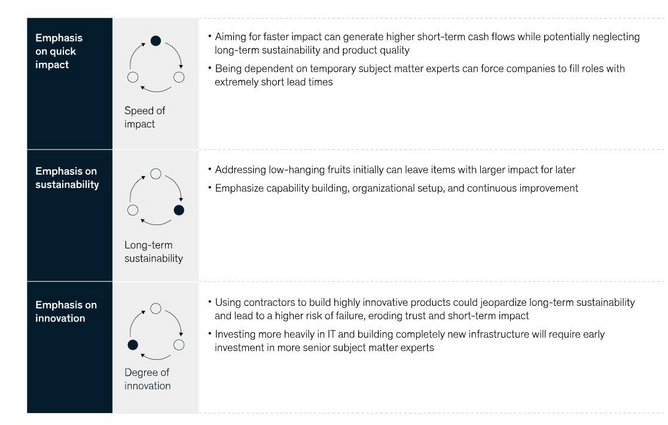McKinsey 5-point plan on supply chain digital transformation

‘New normal’ for supply chains looks nothing like the pre-pandemic ‘normal’. Stability and predictability have been replaced with economic, societal and geopolitcal shocks.
To combat the uncertainty and disruption that has become commonplace, businesses are increasingly looking to digitalise processes and operations, with supply chain and procurement being two areas that can deliver competive advantage if organisations have the digital visibility needed to navigate the never-ending headwinds.
Helpfully, McKinsey has recently published a five-point guide for organisations seeking to digitally transform. The following is a snapshot guide taken from the McKinsey guide to digital transformation.
McKinsey advice: Target senior digital leaders
Ultimately, performance is defined by your talent and technology strategies and the capabilities of the lead data scientists who are driving the transformation.
Such people shape your organisation in multiple ways: screening and hiring candidates, establishing technical standards, and setting the tone for ways of working, such ascollaborating, innovating and maintaining high quality.
Selecting the right individuals for these roles will define the success of your digital transformation. Therefore, it is vital to invest the time needed to conduct a broad search.
The chief digital officer (CDO) is a key contributor to your employee value proposition. The CDO’s experience and credibility will help convince top-tier talent to join the company, which plays a crucial role in achieving the initial wins needed to gain traction, such as successfully developing digital products or setting up technical infrastructure.
McKinsey advice: Rethink digital-talent value proposition
When it comes to talent, there is only so much that a CDO can do.
It is important to consider the local hiring market and talent pool, as well as factors specific to your industry sector, and strive to improve your own work environment in a local context.
Don’t assume you’ll always be competing for digital talent with big tech companies, such as Google and Amazon, because companies tend to compete with other local ventures to attract key technical roles.
Consider how your industry can appeal to each individual candidate’s specific needs. To stand out, you need to be committed to a modern technology stack. Understand the factors that motivate different categories of candidates and adjust your pitch -- and work environment -- accordingly.
Offer development opportunities, including top-tier training programs, or access to educational conferences.
And develop an accurate picture of your tech culture: a mix of skills, mindsets, and work preferences is necessary to build a successful organisation.
Historically, culture has been the number-one barrier to delivering impact from digital initiatives.
McKinsey advice: Be realistic about reskilling
Not all digital talent comes from outside your organisation; most companies have untapped pockets of digital talent.
Not all digital products require sophisticated skill sets. Companies with strong nondigital talent can cover most of their digital needs by upskilling current employees. Being able to spot these people is vital and can be achieved via techniques such as skill surveys.
But it’s important to be realistic about both the number of employees who can be upskilled and the time required to undertake the training and development journey.
The first employees to upskill would be those with high data and technical readiness and who benefit from strong business sponsorship.
Beyond this, companies should place internal hires in positions where they can learn and grow while working alongside more experienced engineers, whether these are hired externally or staffed via a third party.

McKinsey advice: Build learning & development programs
Skills development must extend beyond training because the pace of technological change makes setting up formal training programs difficult.
This is why an on-the-job apprenticeship model works well. This push toward ongoing learning applies both to junior and senior employees. Ideally, they should spend half to two-thirds of their time actively doing day-to-day work.
This way, everyone is involved in developing the final product, improving both upskilling and retention.
Many successful organisations also focus empowering workers to teach themselves.
For example, at Google most training happens via an employee-to-employee network called G2G (Googler-to-Googler). Members of the 6,000-person network offer their time to help peers develop.
But it is important to be realistic. Best-in-class data scientists spend many years in school, and then further years in a working role before being hired by leading firms. It is not possible to re-create this with an internal six-month training program.
McKinsey advice: Leverage temporary contractors
Embedding new skills and culture is vital for the success of any transformation. However, there are trade-offs to be considered between quick wins and sustainability. All companies need these skills; the question is how much, and when.
Contractors can help speed the early stages of a transformation. A number of startegies can help here:
- Ensure early product ownership by internal teams.
- Involve employees on teams from the start.
- Encourage employees to get out of their comfort zones.
- Establish strong protocols and ways of working from the outset.






